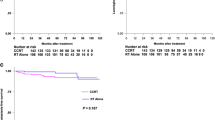Abstract
Objective
The aim of our study was to evaluate the short-term efficacy and the toxic reaction of nedaplatin concurrent with radiotherapy for mid-advanced nasopharyngeal carcinoma and esophageal carcinoma.
Methods
Thirty-four patients were confirmed diagnosis with cancer by pathologic results. All patients were given 6MV X-ray for radiotherapy, Dt 66–70 Gy/33–35 f/6–7 w, concurrently administrated nedaplatin (30 mg/m2) once a week (6 times).
Results
A total 34 patients were enrolled, of whom 33 patients were available for objective response, 1 patient of esophageal cancer quit for allergic reaction. The response rate (RR) of nedaplatin-contained therapy for nasopharyngeal carcinoma and esophageal carcinoma were 90.0% and 76.9%, respectively. The major toxic reaction was bone marrow suppression observed in 25 patients (73.5%), in which grade III aleukocytosis was observed in 3 patients (8.8%), grade III + IV thrombocytopenia in 3 patients (8.8%). And 6 patients (17.6%) showed gastrointestinal tract reaction. There were 4 patients with radiation esophagitis in the 13 patients with esophageal carcinoma.
Conclusion
Nedaplatin can increase the therapeutic effect of radiation. Its incidence rate of bone marrow suppression is high, but the gastrointestinal tract reaction and renal toxicity is low and mild.
Similar content being viewed by others
References
Zhao C, Guan XX. Clinical study on radiotherapy combined with chemotherapy in the treatment of nasopharyngeal carcinoma. Chin J Cancer Prev Treat (Chinese), 2006, 13: 1–4.
Chinese Medical Association. Clinical Practice Guideline of tumor fascicule. Beijing: People’s Medical Publishing House, 2005. 183–204.
Yin WB, Gu XZ. Radiation Oncology (the third edition). Beijing: Peking Union Medical College Press, 2004. 563.
Huang HQ. Research Advances on chemotherapy for nasopharyngeal carcinoma. Guangdong Med J (Chinese), 2002, 23: 335–337.
Sun Y. Internal Medicine Oncology. Beijing: People’s Medical Publishing House, 2001. 528–529.
Adelstein DJ, Li Y, Adams GL, et al. An intergroup phase III comparison of standard radiation therapy and two schedules of concurrent chemoradiotherapy in patients with unresectable squamous cell head and neck cancer. J Clin Oncol, 2003, 21: 928.
Hartmann JT, Lipp HP. Toxicity of platinum compounds. Expert Opin Pharmacother, 2003, 4: 889–901.
Kanzawa F, Koizumi F, Koh Y, et al. In vitro synergisdc interactions between the cisplatin analogue nedaplatin and the DNA topoisomerase I inhibitor irinotecan and the mechanism of this interaction. Clinic Cancer Res, 2001, 7: 202–209.
Inuyama Y, Miyake H, Yamamoto G, et al. A late phase II clinical study of cis-diammine glycolato platinum, 254-s, for head and neck cancer. Gan To Kagaku Ryoho, 1992, 19: 871–877.
Zhang CH, Zhuang W, Yang L, et al. Clinical phase II study on nedaplatin for nasopharyngeal carcinoma/esophageal carcinoma and nonsmall cell lung carcinoma. Oncol Prog (Chinese), 2005, 3: 72–74.
Wang P, Yu XL, Han CS, et al. Preliminary observation of nedaplatin/fluorouracil concurrent with radiotherapy for locally advanced nasopharyngeal carcinoma. Chin Clin Oncol (Chinese), 2005, 10: 191–192.
He XJ, Ma JA, Zhao YS, et al. Clinical analysis of nedaplatin/fluorouracil concurrent with radiotherapy for nasopharyngeal carcinoma stage III and IV. J Mod Oncol (Chinese), 2007, 15: 626–628.
Li F, Li SY, Meng Y. Research advance of nedaplatin a new generation of platinum drugs. J Modern Oncol (Chinese), 2004, 12: 74–75.
Cai XJ, Zhou FX. Clinical observation of low-dose nedaplatin concurrent with radiotherapy for mid-advanced esophageal carcinoma. Chin J Gerontol (Chinese), 2008, 8: 1650–1651.
Wu LZ, Liu HS, Cai W. Clinical observation of nedaplatin concurrent with radiotherapy for mid-advanced esophageal carcinoma. Chin Clin Oncol (Chinese), 2009, 14: 245–246.
Xu RH, Guan ZZ, Jiang WQ, et al. Clinical phase II study on nedaplatin for mid-advanced non-small cell lung cancer. Cancer (Chinese), 2002, 21: 1354–1358.
Ge HT. Clinical observation of 3D-CRT concurrent with chemotherapy for mid-advanced esophageal carcinoma. J Qiqihar Med College (Chinese), 2009, 30: 1996–1997.
kamoto T, Fukada, Ando T, et al. Evaluation of a combination chemotherapy with nedaplatin and 5-Fu for oral cancer. Gan To Kagkn ryoho, 1996, 23: 379.
Yuan XF. Two Cases with Allergic Reaction induced by nedaplatin injection. Chin J Pract Med (Chinese), 2006: 449–450.
Gu LM, Shi CHP. One case with Allergic Shock caused by nedaplatin, J Clin Med Pract (Chinese), 2009, 13: 98–99.
Author information
Authors and Affiliations
Corresponding author
Rights and permissions
About this article
Cite this article
Jie, F., Ge, W., He, P. et al. Clinical observation of nedaplatin concurrent with radiotherapy for mid-advanced nasopharyngeal carcinoma and esophageal carcinoma. Chin. -Ger. J. Clin. Oncol. 9, 652–655 (2010). https://doi.org/10.1007/s10330-010-0705-3
Received:
Revised:
Accepted:
Published:
Issue Date:
DOI: https://doi.org/10.1007/s10330-010-0705-3




